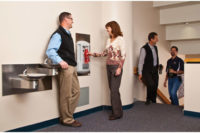Julius Ballanco: Inside the opposition of A2L refrigerants

ASHRAE proposed changes that would have added the provision of addendums “D” and “H” of ASHRAE 15 to the 2021 edition of the IAPMO Uniform Mechanical Code. Following the agreement between the two organizations, text from ASHRAE 15 would have been extracted and printed verbatim in the UMC.
The extraction policy has worked well for many years, with coordination so that the UMC had the latest requirements in Chapter 11 for refrigerant systems. Addendum “D” of ASHRAE 15 contains the requirements for the use of Group A2L refrigerants in high-probability (direct) systems used for human comfort. This change would have allowed the use of low-global warming potential (GWP) refrigerants currently listed by ASHRAE 34. The extract of Addendum “H” would have updated the requirements for the use of Group A2L refrigerants in machinery rooms.
The proposed change was discussed before the IAPMO Mechanical Technical Committee earlier this year. There was two hours of testimony, both pro and con, regarding the acceptance of Group A2L refrigerants for high-probability systems. Leading the testimony in support was ASHRAE staffer Steve Ferguson, who pointed out the decade-long evaluation of A2L refrigerants, before ASHRAE 15 published the regulations. He also identified the millions of dollars of research on A2L refrigerants sponsored by ASHRAE
and AHRTI.
Ferguson was followed by Rusty Tharp, chair of ASHRAE SSPC 15, the committee responsible for the standard. He identified the grueling consensus process necessary to develop safe requirements in the standard.
Supporting testimony was presented by representatives of AHRI, Goodman, Chemours, Arkema, Daikin Applied, Ingersoll Rand (Trane), Carrier, Underwriters Laboratory, Daikin Industries, Mitsubishi, Lennox, Intertek and Daikin US. The supporting testimony was well-coordinated, providing an excellent education on the safe use of A2L refrigerants, the safety requirements in the UL 60335-2-40 standard, and the intense testing requirements for listing a product. Through copious questioning by the Technical Committee, every answer was responded to with technical justification.
Interspersed between the supporting testimony was testimony from Honeywell, JCI and Rheem. Honeywell seemed to be the major player orchestrating the opposition to A2L refrigerants. In what I felt was a disingenuous tip of its hat to low-GWP refrigerants, the company claimed it supported the effort. This was followed by statements slamming A2L refrigerants with scare tactics regarding concerns for life safety and fire hazard. None of the statements were based on fact or supported with technical justification.
You would think, listening to the opposition, any minor leak of A2L refrigerant is going to burst into flames, burning the house down, and killing everyone inside. Rebuttal response pointed out the large quantity of A2L refrigerant that would have to be present, plus the high energy source required for ignition, before any combustion was possible. This was followed by the statement that the standard for listing the equipment requires the implementation of mitigation means when the A2L refrigerant reaches the 25% LFL level, one-fourth the quantity of refrigerant present before it could possibly burn.
The opposition testimony raised concerns with A2L burning and creating HF gas. It quickly was pointed out A1 refrigerant releases more toxic gases than A2L refrigerants, and that any burning refrigerant releases toxic gases.
When a former California fire marshal raised the issue of wildfires, everyone seemed to ignore his comments, since they had been responded to months ago. The former fire marshal indicated he represented Tidwell Consulting, which happened to be the consultant for Honeywell.
When JCI and Rheem testified, they too attacked A2L, saying more time is needed, you need to proceed slowly. They implied that there is more work necessary. The other issue they raised was the lack of reliability of refrigerant detectors. Those comments were easily responded to by representatives of UL, which basically said JCI, Rheem and Honeywell don’t know what they are talking about, done, however, in a very polite way.
ACCA also testified in opposition to A2L refrigerants, claiming there needs to be time to educate the contractor. That seemed like a pointless comment since no contractor would go to training for a product that cannot be installed. There wasn’t much traction to the ACCA comment.
Throughout the testimony, it was obvious that a faction of the Mechanical Technical Committee was predisposed to oppose A2L refrigerants. This was led by labor representatives, and spearheaded by the representative of California State Pipe Trades Council. However, not all labor representatives on the committee opposed the A2L code changes.
During the testimony by UL, one committee member asked why UL published a paper indicating that A2L refrigerants are not safe, especially in multi-split systems. After the paper was presented to the UL staff member, it was determined that the document was produced by Honeywell, and posted on the website, saferefrigerant.com, also a website paid for by Honeywell.
At one point during the testimony, a labor representative challenged a testifier, forcefully asking, “Would you put one of these A2L units in your own home?”
The response was, “Absolutely.”
The chair, Harvey Kreitenberg, quickly returned the meeting to order and calmed down the friction. After two hours of testimony, the Technical Committee finally took a vote. The Technical Committee voted to reject the ASHRAE code change on A2L refrigerants in high-probability systems.
Every vote of rejection requires a technical reason for the justification. The Technical Committee struggled and finally came up with a weak statement. The statement ignored the supporting testimony on A2L refrigerants, which responded to all the issues identified.
More voting
The next vote was on the change to update the machinery room requirements to be consistent with Addendum “H” of ASHRAE 15. The committee voted to reject this change as well. Following the vote of the Addendum “H” code change, it was realized that the technical committee had no justification for rejecting the code change. The committee changed its vote to holding the change until the next cycle, in effect killing the code change for the 2021 UMC.
During the break, one of the technical committee members who voted in favor of approving both changes, said it appears two manufacturers want time to catch up because they haven’t invested in A2L, while one producer is hoping to monopolize the R410A replacement refrigerant market. An interesting observation on two hours of testimony.
Chair Kreitenberg needs to be commended for doing an excellent job directing all of the discussion and keeping decorum in the room. He also allowed extensive testimony, realizing the committee needed to hear all the issues related to A2L refrigerants.
The next step is an electronic vote of the Technical Committee. A two-thirds majority is required for a vote of rejection. The code changes will come up for discussion again at the IAPMO annual conference in Reno, Nevada this month.
The IAPMO membership will be asked to override the Technical Committee and support A2L refrigerants. Their votes can either help the state of California or hurt the UMC.
Looking for a reprint of this article?
From high-res PDFs to custom plaques, order your copy today!






